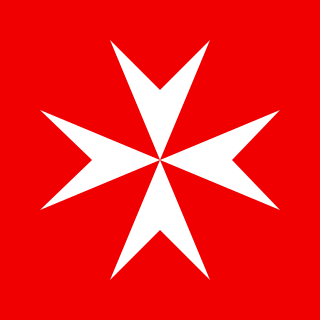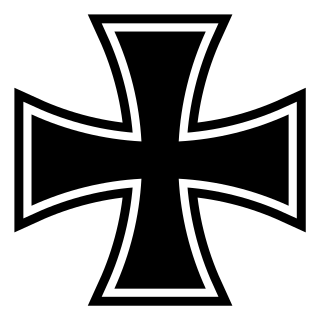
The Iron Cross is a former military decoration in the Kingdom of Prussia, and later in the German Empire (1871–1918) and Nazi Germany (1933–1945). It was established by King Frederick William III of Prussia in March 1813 backdated to the birthday of his late wife Queen Louise on 10 March 1813 during the Napoleonic Wars. Louise was the first person to receive this decoration (posthumously). The recommissioned Iron Cross was also awarded during the Franco-Prussian War, World War I, and World War II . The Iron Cross was normally a military decoration only, though there were instances of it being awarded to civilians for performing military functions. Two examples of this were civilian test pilots Hanna Reitsch who was awarded the Iron Cross 2nd Class and 1st Class and Melitta Schenk Gräfin von Stauffenberg, who was awarded the Iron Cross 2nd Class, for their actions as pilots during World War II.

The Pour le Mérite is an order of merit established in 1740 by King Frederick II of Prussia. The Pour le Mérite was awarded as both a military and civil honour and ranked, along with the Order of the Black Eagle, the Order of the Red Eagle and the House Order of Hohenzollern, among the highest orders of merit in the Kingdom of Prussia. After 1871, when the various German kingdoms, grand duchies, duchies, principalities and Hanseatic city states had come together under Prussian leadership to form the federally structured German Empire, the Prussian honours gradually assumed, at least in public perception, the status of honours of Imperial Germany, even though many honours of the various German states continued to be awarded.

The Order of Merit of the Federal Republic of Germany is the only federal decoration of Germany. It was created by the first President of the Federal Republic of Germany, Theodor Heuss, on 7 September 1951, and has been awarded to over 200,000 individuals in total, both Germans and foreigners. Since the 1990s the number of annual awards has declined from over 4,000, first to around 2,300–2,500 per year, and now under 2,000, with a low of 1752 in 2011. In recent years women have made up a steady 30–31% of recipients. Colloquially, the decorations of the different classes of the Order are also known as the Federal Cross of Merit (Bundesverdienstkreuz).

The Order of the Black Eagle was the highest order of chivalry in the Kingdom of Prussia. The order was founded on 17 January 1701 by Elector Friedrich III of Brandenburg. In his Dutch exile after World War I, deposed Emperor Wilhelm II continued to award the order to his family. He made his second wife, Princess Hermine Reuss of Greiz, a Lady in the Order of the Black Eagle.

The Royal Order of the Crown was a Prussian order of chivalry. Instituted in 1861 as an honour equal in rank to the Order of the Red Eagle, membership could only be conferred upon commissioned officers, but there was a medal associated with the order which could be earned by non-commissioned officers and enlisted men.

The Order of the Red Eagle was an order of chivalry of the Kingdom of Prussia. It was awarded to both military personnel and civilians, to recognize valor in combat, excellence in military leadership, long and faithful service to the kingdom, or other achievements. As with most German orders, the Order of the Red Eagle could only be awarded to commissioned officers or civilians of approximately equivalent status. However, there was a medal of the order, which could be awarded to non-commissioned officers and enlisted men, lower ranking civil servants and other civilians.

The House Order of Hohenzollern was a dynastic order of knighthood of the House of Hohenzollern awarded to military commissioned officers and civilians of comparable status. Associated with the various versions of the order were crosses and medals which could be awarded to lower-ranking soldiers and civilians.
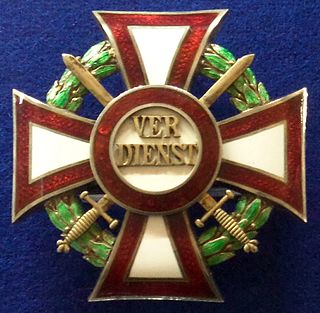
The Military Merit Cross was a decoration of the Empire of Austria and, after the establishment of the Dual Monarchy in 1867, the Empire of Austria-Hungary. It was first established on October 22, 1849 and underwent several revisions to its design and award criteria over the years of its existence. It became obsolete in 1918 with the dissolution of the Austro-Hungarian Empire.

The Military Merit Cross (Militärverdienstkreuz) was established by Friedrich Franz II, Grand Duke of Mecklenburg-Schwerin on August 5, 1848. Mecklenburg-Schwerin, a grand duchy located in northern Germany, was a member of the German Confederation and later the German Empire.

The Bavarian Military Merit Cross (Militär-Verdienstkreuz) was that kingdom's main decoration for bravery and military merit for enlisted soldiers. It was intended "to reward extraordinary merit by non-commissioned officers, soldiers, and lower-ranking officials." It was originally established on July 19, 1866 as the 5th Class of the Military Merit Order, which was the main decoration for bravery and military merit for officers and higher-ranking officials. Civilians acting in support of the army were also made eligible for the decoration.
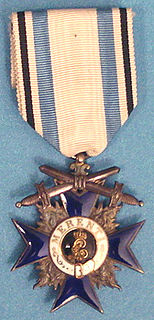
The Bavarian Military Merit Order was established on July 19, 1866 by King Ludwig II of Bavaria. It was the kingdom's main decoration for bravery and military merit for officers and higher-ranking officials. Civilians acting in support of the army were also made eligible for the decoration. The Military Merit Order ranked below the Military Order of Max Joseph (Militär-Max-Joseph-Orden), which was Bavaria's highest military honor for officers.

The Military Merit Cross (Militär-Verdienstkreuz) was the highest bravery award of the Kingdom of Prussia for non-commissioned officers and enlisted soldiers. It was also known as the Golden Military Merit Cross to distinguish it from the Military Decoration 1st Class, a lesser Prussian enlisted bravery decoration which was an identical cross but in silver. The Military Merit Cross came to also be known as the "Pour le Mérite for non-commissioned officers and enlisted men", after the Pour le Mérite, Prussia's highest military decoration for officers.

The House and Merit Order of Duke Peter Frederick Louis or proper German Oldenburg House and Merit Order of Duke Peter Frederick Louis was a civil and military order of the Grand Duchy of Oldenburg, a member state of the German Empire. The order was founded by Grand Duke Augustus of Oldenburg on November 27, 1838, to honor his father, Peter Frederick Louis of Oldenburg. It became obsolete in 1918 after the abdication of the last grand duke.

The Hanseatic Cross (Hanseatenkreuz) was a military decoration of the three Hanseatic city-states of Bremen, Hamburg and Lübeck, who were members of the German Empire during World War I. Each republic established its own version of the cross, but the design and award criteria were similar for each.

The Cross for Merit in War was a military decoration of the Duchy of Saxe-Meiningen established by Bernhard III, Duke of Saxe-Meiningen on 7 March 1915.

The Merit Cross was a meritorious service decoration of Prussia. Established 27 January 1912, by Wilhelm II in his capacity as King of Prussia, it recognized general merit to Prussia. The cross could be awarded to civilians as well as members of the military. The cross was awarded in two classes a gold cross and a silver cross.
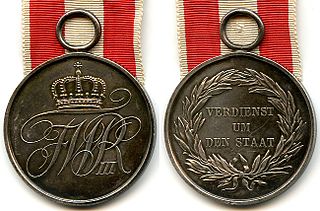
The General Honor Decoration was a decoration of Prussia. The decoration can trace its origin back to awards established in 1793 by King Frederick William III of Prussia. The various levels of the decoration recognized peacetime merit to Prussia. These awards were often to commemorate long and particularly meritorious service or for special contributions from people who would not be considered for appointment to an order due to their rank. In general, recipients were lower and mid-level officials and officers.

The Military Honor Medal was a two-class military decoration awarded by the Kingdom of Prussia. The medal was awarded to military personnel from the rank of sergeant and below. Established in 1814, it replaced the Gold Military Merit Medal of 1806, with a medal in the shape of a cross silver cross for the 1st class while the Silver Military Medal of 1806 became the 2nd class with minor changes in design.

The Jerusalem Cross or Jerusalem Memorial Cross was a decoration of Prussia established 31 October 1898. The cross was awarded to those who traveled with Emperor Wilhelm II on his 1898 visit to Palestine and attended the inauguration of the Lutheran Church of the Redeemer, Jerusalem.

The Düppel Storm Cross was a military medal of the Kingdom of Prussia. The cross was awarded to Prussian participants in the Battle of Dybbøl which took place on 18 April 1864, during the Second Schleswig War. Established by Wilhelm, King of Prussia on 18 October 1864, the cross was initially awarded to combatants and noncombatants who directly participated in the battle. The following year, versions were created for those troops held in reserve at the battle and members of the Johanniter Orden who participated in the battle.



